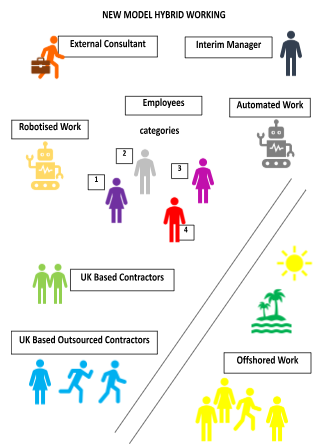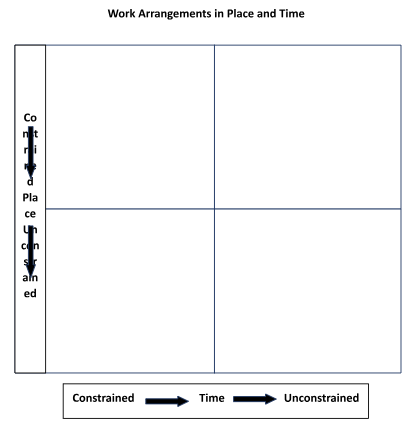Can You Handle the Truth? – The Work Environment After the Coronavirus Pandemic
- Brainz Magazine

- Jul 22
- 3 min read
John Gelmini, aka John Alexander, is an international consultant, trainer, and interim transformation leader. He has completed 80 engagements since 1995, has helped raise £650 million, and jointly wrote Can You Handle the Truth.

The future of office-based work is undeniably shifting, with remote work presenting both opportunities and challenges. While some employees thrive in home environments, others may struggle with the necessary discipline and space, creating a need for targeted support and structured solutions. Let's explore the complexities of remote work, highlighting the need for segmentation, training, and tailored strategies to ensure productivity, engagement, and mental well-being across different employee categories.

It is quite clear that the patterns of work for office-based employees are going to change forever.
There are those who imagine that all such employees can be encouraged or forced to work from home, but this presents several difficulties:
Not all people are psychologically suited to remote working or have the personal discipline to work in an unsupervised and potentially unstructured manner,
Home environments are, in many cases, not large enough to allow for productive homeworking.
Employers may be tempted, as some already have been, to outsource or offshore home-based roles to better-qualified, better-educated, better-motivated, and less expensive workers.
a. This is not good for morale and has tax implications for governments struggling to provide public services with diminishing revenues.
b. There are issues within this for mental health, engagement, productivity, and teamwork. These need to be carefully thought through by employees, business leaders, by local and national governments. The solution does not lie in doing nothing, “leaving it to market forces”, or imagining that it will resolve itself by osmosis.
Employees will have to be segmented into several categories and given training, mentoring, and tangible support:
Category 1
Employees with the right home environment, personal organisation, self-discipline, mental and emotional makeup to operate alone from home or a teleworking site.
Category 2
Employees without the right home environment who could be trained and mentored into Category 1 with the right support and a remote/in-house “drop-in”/hot desk facility.
Category 3
Employees whose role is naturally client-facing but, for compliance and regulatory reasons, need to have their work outputs cross-checked and reviewed, such as social workers.
Category 4
Employees whose work is of such a nature that it must be done in an office and be closely supervised.

Various articles, such as the one in Harvard Business Review (May/June 2021) edition by Lynda Gratton, “Doing Hybrid Right”, cover some of the relatives of work. There is no one size fits all but work has to be considered in terms of place, time, suitability of location, nature of work, employee preference, competitive needs, engagement, productivity, cost, and the intelligence levels versus what the job demands need to be sense checked and adjusted to reflect the realities of housing suitability and pricing, ambient noise, nature of work, employee preference, competitive needs and the intelligence of workers versus what the job demands and costs. Thus, her ‘Work Arrangements in Place and Time’ is replicated here.

Anywhere 9 to 5
Anywhere, anytime
Traditional Office 9 to 5
In the Office Anytime
Much work is now becoming polarised so that at the lower end, 15% of the global population who have IQs below 83 (some 1.2 billion people) will be incapable of doing any job that the Pentagon or wider society wants done. ¹ No one knows what to do with people in this category, but the humane solution would seem to be homesteading and Universal Basic Income. Above that, we have blue-collar jobs that can be replaced by robots, such as:
Manufacturing assembly of factory-produced goods.
Machine operation.
Welding, painting, running production lines, mining, crane operation, tunnelling, boring, teaching assistance (used in the Far East for some years).
Factory production of systems-built houses, office blocks, skyscrapers, and infrastructure, warehousing, and cleaning.
Other work in finance, law, insolvency practice, and actuarial calculations can be automated using AI and Robot Processing Automation (RPA), leaving the more complex areas to human subject matter experts. At the higher end, we have the singularity.
This is the area where superworkers with injected expert systems positioned on nanochips do the most technically difficult and complex work.
Read more from John A. Gelmini
John A. Gelmini, Mgt Consultant, Interim Leader & Business Mentor
John Gelmini, aka John Alexander, is an expert at optimising productivity, profitability, and sales in culturally diverse and monochrome environments. As an ex-GE Capital troubleshooter, John understands how to effect transformation in challenging environments in the corporate, public, NGO, and foreign government sectors with strategic insight and speed. He is the founder of TRANSFORMATION and believes in "mission completion" to time, budget, and accelerated roadmaps to benefits realisation.
Resources:










.jpg)